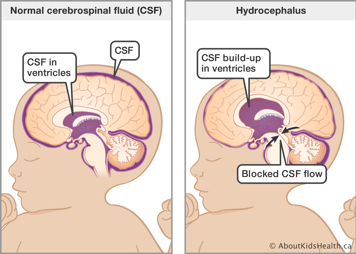What is hydrocephalus?
Hydrocephalus is an abnormal build-up of cerebrospinal fluid (CSF) in the ventricles inside the brain. The ventricles are fluid-filled spaces in the brain. CSF is a clear, colourless fluid that looks like water and contains small amounts of salt, sugar and cells.

CSF is constantly produced in the ventricles. It moves around the brain and spinal cord, is absorbed and is then replaced by new CSF. Some of the functions of CSF are:
- to protect the brain and spinal cord from injury
- to nourish brain cells, which helps with brain functioning
- to carry waste products from brain cells away
CSF moves around the brain and spinal cord on a specific pathway. When too much CSF gets trapped anywhere along this pathway, it can expand the ventricles and put pressure on the brain. This condition is called hydrocephalus.
There are two categories of hydrocephalus:
- Communicating hydrocephalus is the build-up of pressure from too much CSF that is not being properly absorbed.
- Non-communicating hydrocephalus is the build-up of pressure from CSF when a blockage occurs within the brain. Some causes of non-communicating hydrocephalus may be a tumour, a blood clot, or a narrowing of part of the CSF pathway found at birth.
A person born with hydrocephalus is said to have congenital hydrocephalus. Those who develop it later in life are said to have acquired hydrocephalus.
Signs of hydrocephalus
To find out if your child has hydrocephalus, their health-care provider will assess your child and do some tests.
Signs of hydrocephalus in a baby
Your baby may have some or all of the following symptoms:
- poor feeding
- vomiting (throwing up)
- sleepy (hard to wake up) or not as awake or alert as usual
- large head (your child’s health-care provider can measure this)
- bulging soft spot (fontanelle) on the top of the head
- seeming irritable (cries easily or without reason)
- seizures
- very noticeable scalp veins
- slowness at reaching milestones (for example, slow to roll over, slow to sit) or loss of milestones (for example, was sitting or walking and now unable)
- "sunset" eyes, when the eyes appear to be always looking down and are not able to look up
Signs of hydrocephalus in a child
Your child may have some or all of the following symptoms:
- headaches
- nausea and vomiting
- tired (sleeping more than usual, difficult to wake up, does not want to play as usual)
- seeming irritable
- changes in personality, behaviour or school performance
- loss of coordination
- seizures
- changes in vision
Hydrocephalus is diagnosed with a CT scan, MRI or ultrasound
Hydrocephalus is often diagnosed with imaging tests. These tests include computed tomography (CT) scans, magnetic resonance imaging (MRI) and ultrasound. These technologies give health-care providers different views of what is going on inside the brain. These imaging tests may reveal a blockage or a build-up of CSF.
Using MRI and ultrasound, hydrocephalus is sometimes diagnosed before a child is born.
Because CT scans and MRI require a person to be still while the pictures are being taken, some children need to be given sedation to help them keep still during the tests.
Hydrocephalus is treated with surgery
There are no effective medicines for hydrocephalus, and most children require surgery. The goal is to lessen the pressure in the brain by providing another pathway for CSF to be drained and absorbed away from the brain.
There are two types of surgery for hydrocephalus:
- The most common treatment is the insertion of a CSF shunt. The shunt works by moving fluid from an area where there is too much CSF to an area where it can be absorbed into the body.
- Some children with non-communicating hydrocephalus can have surgery called an endoscopic third ventriculostomy (ETV). This surgery creates an opening to allow CSF to flow in and around the brain as it should. Sometimes, an ETV is done in combination with a procedure called choroid plexus cauterization (CPC).
These surgeries are described in detail in the following AboutKidsHealth articles:
When to seek medical attention
If you see any signs or symptoms of increased pressure in the brain, it is important to call 911 or take your child to your nearest Emergency Department.
At SickKids
The Neurosurgery unit is located on 5C, 5th floor of the Atrium.
The Neurosurgery clinic is located on 6C, 6th floor of the Atrium. Phone: 416-813-5222.
